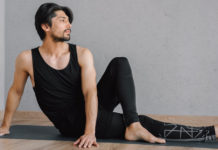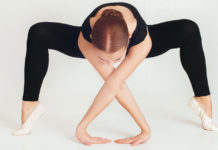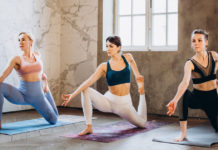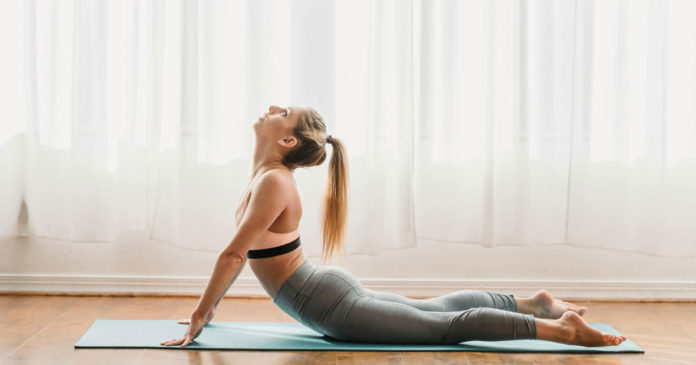Welcome to this article, where we will look at and learn about two classic yogic poses: the Cobra vs Upward Dog. These positions are often done in yoga sessions and have several health and mental advantages.
The Cobra Pose, referred to in Sanskrit as Bhujangasana, is a backbend that extends and improves the spine, your shoulders, and chest. It entails laying on your stomach with your hands behind your shoulders and elevating the upper part of your body while maintaining your pelvis stable. This position may help you improve your posture, decrease tension, open up your chest, and boost your flexibility.
The Upward Dog position, also known as Urdhva Mukha Svanasana, is a comparable backbend position with several important changes. In yoga, it is often practiced as a component of the Sun Salutations sequence. To begin this position, lie prone on the mat with your palms beside your waist. As you inhale, push your hands into the ground to raise your chest off the ground, keeping your legs stretched behind you. Unlike in Cobra Pose, when just the hands are utilized for support, both hands and the tops of the feet are anchored on the mat in Upward Dog Pose.
Advantages
While both postures have comparable advantages for spine health and flexibility development, their differences make them appropriate for practitioners of varying levels. Because it involves less effort to raise off the floor than Upward Dog Pose, It often regards the Cobra vs Upward Dog as more approachable for novices or those with weak upper body strength.
Understanding Cobra vs Upward Dog may help you improve your yoga practice by adding them into sequences or concentrating on particular areas of growth like back strength or chest opening. Before trying any new postures, remember to pay attention to your body’s limits and, if necessary, speak with a trained teacher.
In the next parts, we’ll go over Cobra vs Upward Dog posture cues, adjustments for various levels, and variants to help you get the most possible from your yoga practice. So let’s get started and discover the realm of Cobra vs Upward Dog Pose!
The Anatomy and Alignment of Cobra Pose
A popular yoga position, cobra pose, which is Sanskrit-named Bhujangasana, provides an array of physical and mental advantages. To completely reap these advantages, it is critical to comprehend and execute the position correctly.
The alignment of the Cobra vs Upward Dog is critical to its efficacy. Begin by lying down on your stomach and extending your legs behind you. Place your hands beside your shoulders on the mat, fingers pointing forward. Press your hands into the floor and gently elevate your upper body off the floor while maintaining your pelvis anchored as you inhale. Check that the elbows are bent slightly and near to your body.
Focus on extending through your spine rather than depending exclusively on arm power to maintain good posture. Maintain a calm posture with your shoulders away from your ears, and slowly bring them forward to open up your chest. Engage your core muscles to stabilize your lower back and prevent undue compression.
To completely benefit from cobra position, it is vital to practice it properly. Regular execution of this asana may help develop the spine, increase back muscular flexibility, activate abdominal organs, and improve overall posture.
As with any yoga pose, it is important to respect your body’s limits and refrain from pushing oneself into deeper variants if it causes pain or suffering. If you are new to cobra posture or have any pre-existing health issues or injuries, consult with a competent yoga teacher for individualized modifications and adjustments.
Remember that carefully practicing Cobra vs Upward Dog with good alignment may result in a safe and satisfying encounter on both mental and energy levels.
The Anatomy and Alignment of Upward Dog Pose
Upward Dog Pose, whose Sanskrit name is Urdhva Mukha Svanasana, is a fundamental yoga position that provides a multitude of mental and physical advantages. Understanding the appropriate alignment of this posture is critical for optimal efficacy and avoiding injuries.
Begin by extending your legs behind you while reclining face down on the floor mat. Put your hands close to your shoulders, fingers spread out with palms firmly pressed into the carpet. As you inhale, push your hands into the ground to raise your upper body off the ground, keeping your knees connected and the tops of your feet pressing down.
It’s critical to remember some essential aspects when it comes to alignment. To begin, make sure your wrists are squarely beneath your shoulders, forming a straight path from your fingers to your elbows. This helps to appropriately distribute weight and minimizes excessive wrist strain.
Next, move your core muscles into your spine to activate them. During the position, this gives support and stability for the lower back. Take care not to give way into or droop your lower back.
Avoid slumping into your shoulders or pulling them up towards your ears as you raise into the chest. Roll them backwards and down, expanding over the collarbones. This opens up the heart core and improves good posture.
Focus on stretching through each side of one’s body from top to toe to keep good alignment in upwards dog position. Maintain a modest involvement in the glutes avoiding undue grasping or clenching.
Benefits of performing upward dog
The benefits of performing upward dog pose include arm, wrist, and spine strengthening, chest and lung stretching, posture improvement, stimulation of abdominal organs, alleviation from minor depression or exhaustion, and general energizing effects.
Note that every person’s physique is different, so pay attention to yours while doing this position. If you feel any difficulty or pain while doing upward dog posture, adjust or seek the advice of a competent yoga teacher.
You may get the full advantages of this exhilarating and heart-opening position by knowing and properly aligning your body in an upward dog stance.
Differentiating Between Cobra and Upward Dog Poses: Key Points to Note
Understanding the distinctions between Cobra vs Upward Dog positions is critical for every yoga practitioner. While these stances may look identical at first sight, there are crucial differences that distinguish each pose.
Cobra vs Upward Dog, additionally referred to as Bhujangasana, is performed by laying down with your face on the mat and placing your hands behind your shoulders. As you inhale, use the power of the muscles in your back to steadily raise your upper body off the ground. Cobra position focuses on the vertebrae and helps to enhance mobility in the area of the lower back.
Conversely, Urdhva Mukha Svanasana, also known as upward dog pose, represents a more sophisticated iteration of cobra pose. To begin this position, lie prone on the mat and your palms beside your ribs. As you inhale, push your hands together and raise your torso and legs off the ground, leaving just the edges of your feet on the ground. Upward dog strengthens not just the back but also the shoulders and arms.
While these positions have commonalities, such as strengthening and stretching the back muscles, they also have significant variances. In Cobra vs Upward Dog, just the upper part of the body is elevated off the ground, but in upward dog position, both the upper and lower bodies are lifted at the same time.
Difficulty
The amount of difficulty varies from person to person, based on their specific flexibility and strength. It is often regards Cobra posture as simpler to accomplish at first for novices or those with weak upper body strength. However, with regular practice and adequate alignment advice from a trained teacher or professional, an upward dog is also possible.
Ultimately, whether one prefers Cobra vs Upward Dog depends on their unique ability and yoga experience. To prevent damage, pay attention to your body’s limits and progressively proceed to more difficult versions under professional instruction.
Conclusion
In conclusion, knowing the distinctions from Cobra vs Upward Dog positions enables practitioners to adjust their practice of yoga to their unique requirements. Both positions have distinct advantages and it may includes into a complete yoga regimen.
When to Practice Cobra Pose vs Upward Dog Pose: Choosing the Right Variation for Your Practice
Whenever it comes to yoga, it’s crucial to choose the correct variety for your physical condition and requirements. Cobra vs Upward Dog are two exercises that frequently performs in yoga. While they may seem to be comparable, there are times when one position is more advantageous.
When you want to concentrate on developing the back muscles and developing spinal flexibility, try the Cobra Pose. It is often advisable for beginners or people with lower back concerns since it puts less strain on the wrist and shoulders than Upward Dog.
Upward Dog Pose, conversely, is typically incorporated into a fluid sequence of movements, including Sun Salutations. You need to be stronger in your upper body and more flexible in your arms, shoulders, and back to do this pose. Those seeking to expand their torso and strengthen their limbs may find this to be an excellent option.
Carefully consider your body and pick the version that suits you best. Consider moving to Cobra vs Upward Dog if you’re experiencing pain or injury in your wrists or shoulders. Nevertheless, in the absence of such limitations or injuries, Upward Dog may prove to be an excellent choice for those seeking a more strenuous position.
Bear in mind that yoga is an individual endeavor; therefore, it is critical to respect the requirements and limitations of your own body. A trained yoga teacher may also give helpful advice on selecting the best variant for your practice.
Conclusion: Embrace the Benefits of Both Poses in Your Yoga Journey!
Finally, while practicing yoga, be sure to include both Cobra vs Upward Dog for maximum effect. These postures each have their own distinct benefits and may integrates into your program according to your body’s requirements.
Typically executed with the soles of the feet planted on the mat, Cobra Pose induces a mild inward curvature that benefits spinal fortification, thoracic expansion, and posture enhancement. It may be good for those who want to develop back flexibility and relieve lower back discomfort.
In contrast, while doing Upward Dog, it is common practice to elevate the soles of the feet off the mat. This allows the spine to extend farther. The front body is stretched while the limbs, forearms, and shoulders are strengthened in this pose. Particularly beneficial for those who wish to strengthen their upper bodies and enhance their overall posture.
It is critical to select variations of Cobra vs Upward Dog that feel secure and pleasant for you when deciding between them. Before trying these postures, speak with a skilled yoga teacher or healthcare practitioner if you have any current ailments or limits.
Remember that each person’s yoga path is unique, so feel free to adjust or adapt postures as required. You can get the most out of your yoga exercise by carefully doing both Cobra Pose as well as Upward Dog. This will help your mental and physical well-being.








